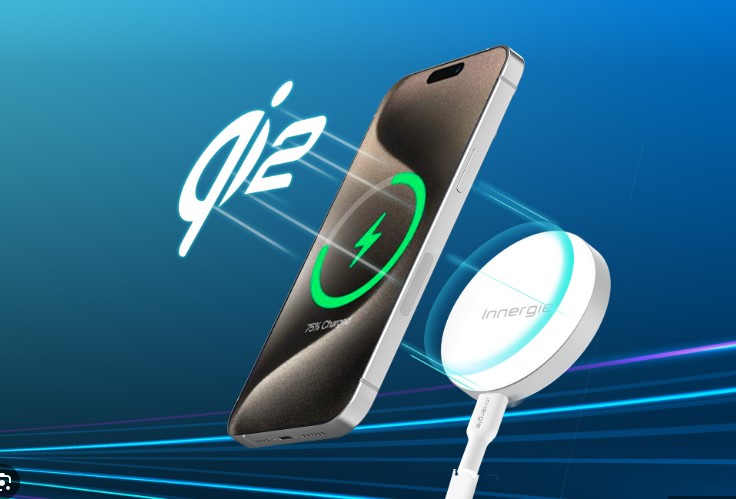
What Is Qi2 Wireless Charging? Everything You Need to Know About Qi2
July 28, 2025What Is Qi2 Wireless Charging—and Why It Matters
Qi2, rolled out by the Wireless Power Consortium (WPC) in early 2023, is the next-generation upgrade to the original Qi wireless charging standard. It introduces a Magnetic Power Profile (MPP) inspired by Apple’s MagSafe system, offering improved alignment, faster speeds, and greater efficiency over classic Qi charging (WIRED).
Wireless charging has become an increasingly prevalent technology due to its convenience and efficiency. The advent of Qi2 only enhances this trend. With the rise of smart devices, the need for more efficient charging solutions has intensified. The Qi2 standard not only supports faster charging but also encourages manufacturers to innovate further in the wireless charging space, which is critical as our devices become more integral to our daily lives.
Key Innovations in Qi2
- Magnetic Alignment: Devices labeled Qi2 include a ring of magnets around the charging coil. When paired with a Qi2 charger, this alignment ensures precise coil positioning—eliminating “dead spots,” boosting energy transfer, and reducing power loss as heat (WIRED).
Additionally, magnetic alignment not only prevents misalignment issues but also contributes to the longevity of the device’s battery. For instance, when a device is not aligned correctly on a charging pad, it can lead to extended charging times and increased heat generation. By implementing magnetic alignment, Qi2 ensures optimal charging efficiency and prolongs the battery’s overall lifespan, a crucial benefit for users who frequently rely on wireless charging.
- Faster Charging Speeds: Qi2-certified devices can charge at up to 15 W—three times faster than the original Qi baseline of 5 W and matching Apple’s exclusive MagSafe rate. The newer Qi2 25W variant, released in mid‑2025, boosts that limit to 25 W—roughly 70% faster—delivering about 50% battery in 30 minutes on compatible devices (Lifewire).
The speed of charging is also a significant aspect of user experience. Imagine being able to power up your device while you prepare for the day or during quick breaks. Qi2’s faster charging capabilities mean that users can acquire a substantial battery charge in a fraction of the time compared to older technologies. Furthermore, the introduction of the Qi2 25W variant is a game-changer, providing users with the ability to charge not just smartphones but also larger devices such as tablets and wireless earbuds more quickly.
- Cross‑Platform Compatibility: Qi2 is an open standard—designed to bridge both iPhones and Androids. Qi2-certified chargers and devices should interoperate seamlessly. Early support has already come from Apple (iPhone 15 and 16 series) while major Android manufacturers like Samsung and Google are joining the certification lineup in 2025 and beyond (WIRED).
This cross-platform compatibility is a significant factor in today’s market. As consumers often possess multiple devices from different manufacturers, having a universal charging standard simplifies the user experience. With Qi2, users can enjoy a seamless charging experience across their devices, which fosters customer loyalty and encourages the adoption of Qi2 certified products across various brands.
Compatibility Notes & Confusion Beware
- Qi2 devices still support older Qi chargers—but often at lower speeds. However, not all legacy Qi chargers will work properly with Qi2 devices. For example, the HMD Skyline (an early Qi2 Android phone) failed to charge with some older Qi pads (WIRED).
A prime example of this compatibility issue can be seen with popular devices like the iPhone 15, which have been designed with Qi2 in mind. By understanding the limitations of older chargers, consumers can make more informed decisions about upgrading their charging equipment to ensure they benefit from the latest improvements in technology.
- Many new Android models, such as the Galaxy S25 family and Z Fold7/Flip7, are labeled Qi2-Ready. They lack built-in magnets but can support Qi2 alignment and charging when used with specially certified magnetic cases (WIRED).
Why Qi2 Changes the Game
The introduction of Qi2 is pivotal as it sets a new industry benchmark. As technology evolves, the need for improved safety measures becomes more critical. With the ongoing development of wireless charging technologies, Qi2 addresses these concerns by implementing advanced thermal management systems that not only enhance performance but also safeguard users against potential hazards such as overheating.
Qi2 offers a more reliable and efficient charging experience:
- Greater Safety & Less Heat: Magnet-controlled alignment and improved thermal monitoring help reduce heat buildup—protecting battery health and enhancing safety (Qi).
- Broader Accessory Ecosystem: Because Qi2 is an open standard, accessory makers (like Belkin, Anker, Ugreen, Mophie, and Baseus) are releasing certified chargers and magnetic accessories that work across devices—no longer locked into proprietary systems (The Verge).
In addition, the broader ecosystem of accessories created due to the open standard approach of Qi2 fosters innovation. Accessory manufacturers have begun to develop unique and versatile products that cater to the Qi2 standard, allowing users to personalize their charging experience while ensuring compatibility. For instance, magnetic cases, charging stands, and multi-device chargers are just a few examples of how the Qi2 ecosystem is evolving.
- Future‑Proofing: As more devices and chargers become Qi2‑25W certified, users can expect faster wireless charging that’s more universally compatible across brands and models (Android Central).
As we look towards the future, the growing adoption of Qi2 will likely influence the design of new devices. Manufacturers may prioritize compatibility and efficiency, knowing that consumers prefer devices that can easily integrate into their existing charging setups. This shift could lead to more innovation in device design, pushing the boundaries of what is possible with wireless technology.
In Summary
Qi2 enhances wireless charging with magnetic alignment, faster speeds (15W and now 25W), and improved compatibility across the iOS and Android ecosystem. While rollout is still ramping up—and some legacy products may not interoperate—expect Qi2 to become the new baseline in wireless charging throughout 2025 and beyond (Belkin US).
Moreover, the potential for Qi2 to become the standard in public charging stations is another exciting development. As cities and businesses adopt Qi2 technology, users will benefit from the convenience of charging their devices in various locations, including cafes, airports, and public transport hubs. This widespread adoption will further solidify the importance of wireless charging in our daily routines.
In conclusion, the advancement of wireless charging technology through Qi2 is a significant leap forward. It enhances efficiency, interoperability, and safety, setting the stage for a future where wireless charging is the norm. As users continue to seek convenience and reliability, Qi2 is poised to become a vital aspect of our charging habits. What Is Qi2 Wireless Charging—and Why It Matters is a crucial discussion as we navigate this exciting technological frontier.
